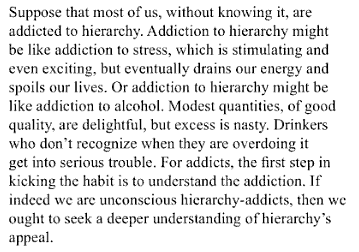How should we draft an information architecture?
13 de setembro, 2009It doesn't matter who had the idea
2 de dezembro, 2009I just finished reading a very interesting book named “The Three Ways of Getting Things Done“:


It is about hierarchy, heterarchy and responsible autonomy in organizations.
Gerard main thesis is that the human being is addicted to hierarchy and, because of this addiction, we are unable to consider other options for getting things done. He says that people organize themselves into groups (organizations) in order to get things done and since we are addicted to hierarchy, we believe this is the only way to get things done.
The first paragraph of the book:

The book explains not only why we are addicted to hierarchy, but also that there are other option to hierarchy besides chaos. He introduces two concepts:
- Heterarchy: “is the divided, supported or dispersed rule where control shifts around depending on the project and the personality, skills, experience and enthusiasm of those who can make things happen. Much of the project work that is becoming common in large technology companies fits this kind of arrangement.”
- Responsible autonomy: “an individual or a group has autonomy to decide what to do, but is accountable for the outcome of the decision.”
Hierarchy, heterarchy and responsible autonomy form the Thriarchy. Gerard says we should use a mix of the three forms of getting things done, instead of sticking to only one:
There are three ways of getting things done in organizations and the combination of the three is called triarchy, which means triple rule. The Three Ways of Getting Things Done: Hierarchy, Heterarchy and Responsible Autonomy in Organizations.When I was young I thought hierarchy was the only way to run organizations. Although in those days I’d barely heard of the great sociologist Max Weber, I unknowingly shared his belief that an organization couldn’t exist without a hierarchical chain of authority. Now, after over fifty years working in organizations of many different kinds, I’ve come to realise there are two other, equally important, ways of getting things done and that it’s vital for us to understand these other ways. We also need to understand why hierarchy always seems to trump the others.
Today almost all the organizations use hierarchy almost all of the time. According to Gerard:
There is good evidence to suggest that, in the 21st century, organizations are significantly changing the way they get things done. The result, triarchy theory suggests, will be a gradual move away from hierarchy in organizations.
Thiarchy has strong links to sociocracy, Peer-to-Peer theory, complexity theory and Spiral Dynamics.
It is a must read book on the participative management subject.
For those willing to read its first 2 chapter, you can use Google Books:
